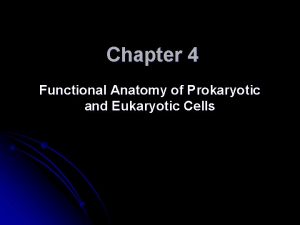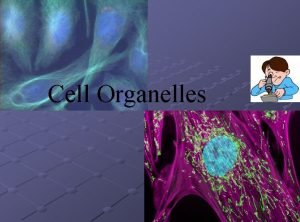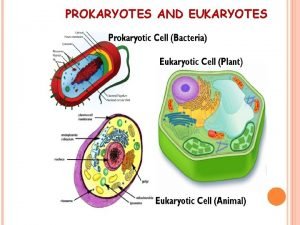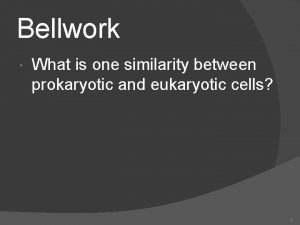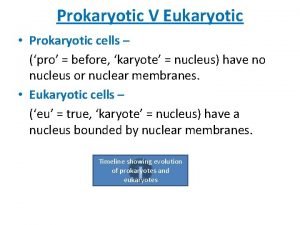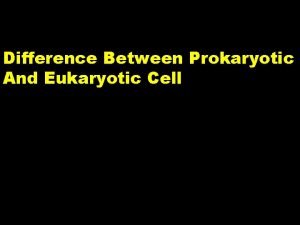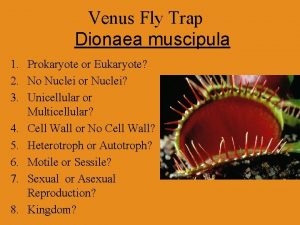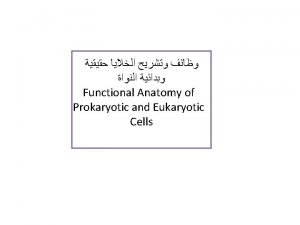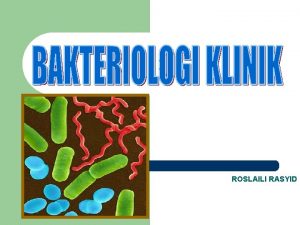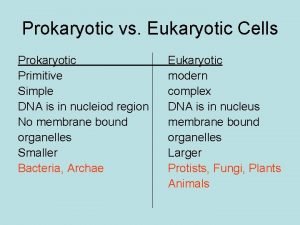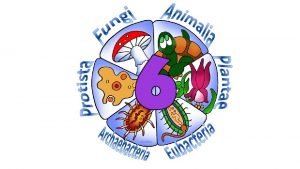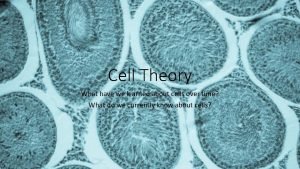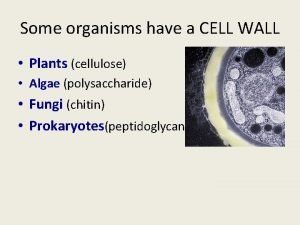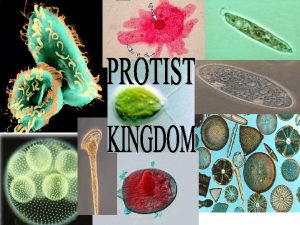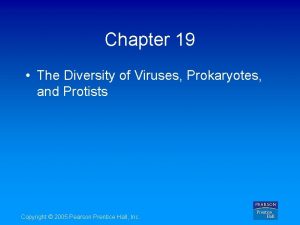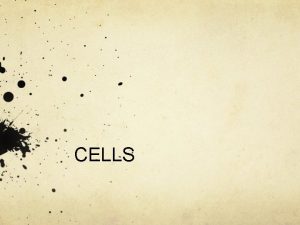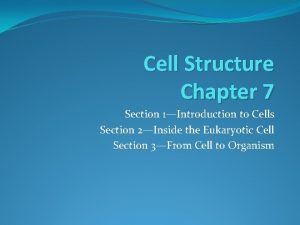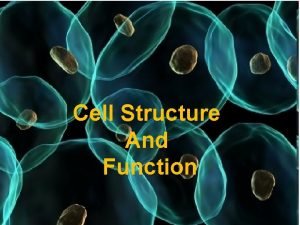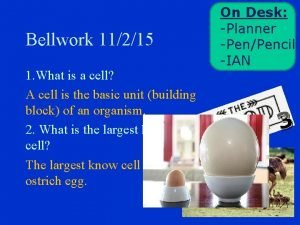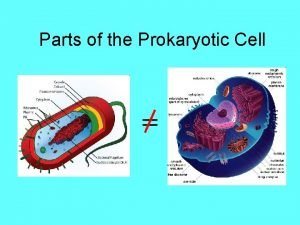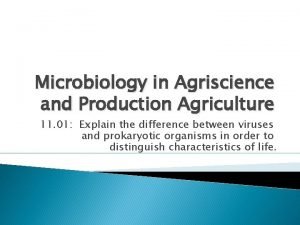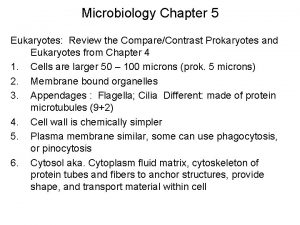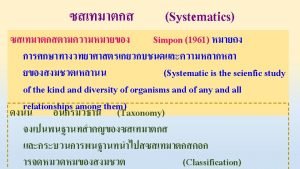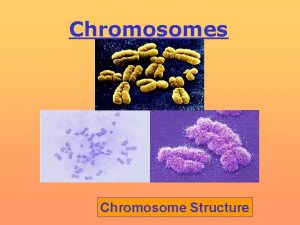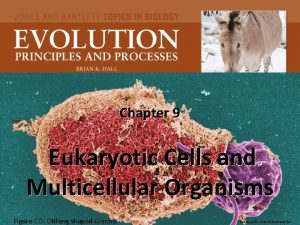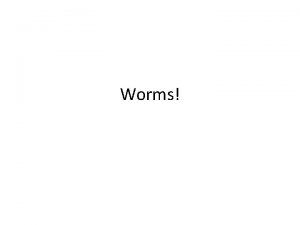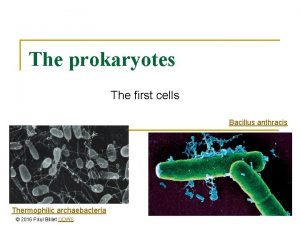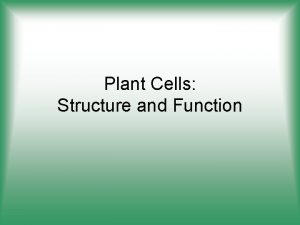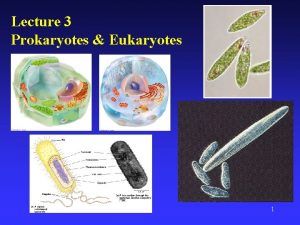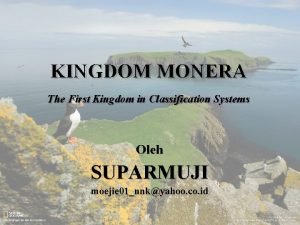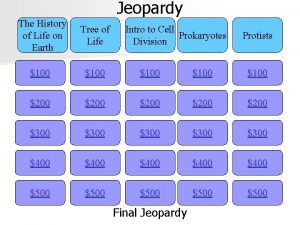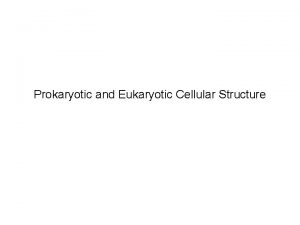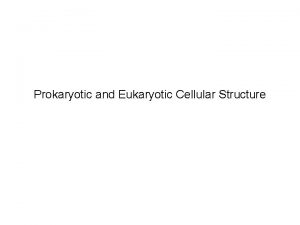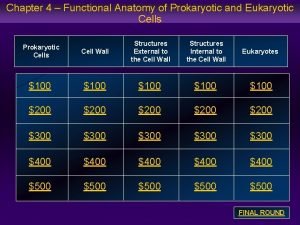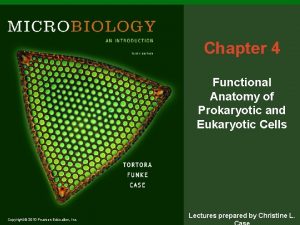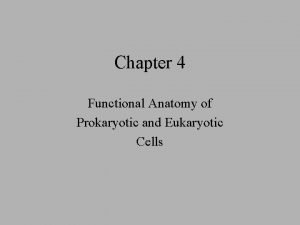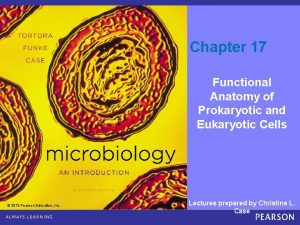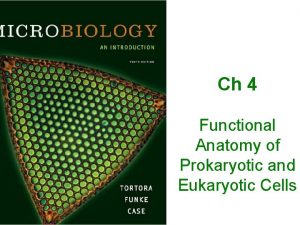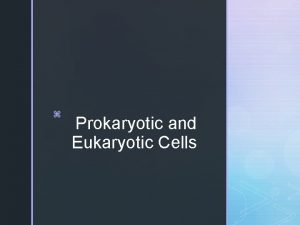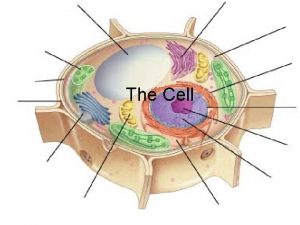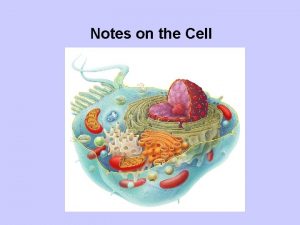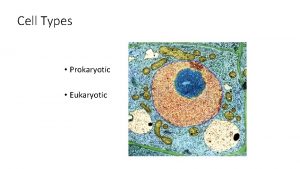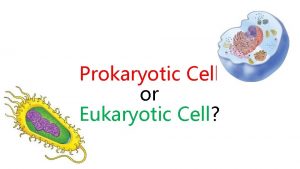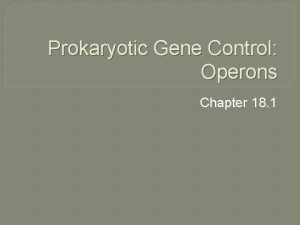Chapter 4 Functional Anatomy of Prokaryotic and Eukaryotic

















































- Slides: 49

Chapter 4 Functional Anatomy of Prokaryotic and Eukaryotic Cells

l Prokaryotes can be grouped based on morphology l l Genetically determined l Monomorphic vs pleomorphic Size Range l 0. 2 to 80 um in diameter l 2 to 600 um in length l Average size: 0. 2 -1. 0 µm × 2 - 8 µm

Morphology of Prokaryotic Cells l Prokaryotes exhibit a variety of shapes l Most common

l Spiral

l Uncommon Shapes Stella Haloarcula

l Cells may form groupings l Cells adhere together after division l Form characteristic arrangements l Depends on plan of division

Neisseria Enterococcus Micrococcus Sarcina Staphylococcus aureus

Bacillus anthracis Bacillus megaterium Bordetella pertussis


Layers External to Cell Wall l Glycocalyx l Made inside the cell; excreted to surface l General functions l Protection l Attachment l Motility

l Capsule or Slime Layer l Chemical composition varies depending on species

Flagella l l Naked filaments composed of flagellin Rotate clockwise/counterclockwise l Runs and tumbles l Taxis

l Flagella structure has three basic parts l Filament l Hook l Basal body

Polar - Monotrichous Polar -Lophotrichous Peritrichous Polar -amphitrichous

Axial filaments l Bundles of endoflagella that spiral around cell l Spirochete bacteria only l Corkscrew motion

Attachment Proteins l Fimbriae - bacteria l l l Hami – archaea l l l Filaments of pilin protein Attachment Hooked protein filament Attachment Sex Pili l l Pilin tubules Exchange of DNA

• • Cannulae – thermophilic archaea Spinae - marine bacteria • • Connect cells over distances Creates mesh-like network

Prokaryotic Cell Wall Determines shape of cell l Protects from osmotic pressure l Anchor point for flagella l Contributes to virulence l

l Unique chemical structure l Bacteria vs. Archaea l Gram positive vs. Gram-negative l Peptidoglycan (PTG) (murein) l Sugar found only in bacteria l Archaea may have proteins or alternate sugars

l Basic structure of PTG l Disaccharide polymer N-acetylglucosamin (NAG) l N-acetylmuramic acid (NAM) l l Glycan chain held together by amino acids l l Tetrapeptide chain Protein crossbridges may or may not be present l Mostly G+

l Gram positive cell wall l Thick layer of PTG l Teichoic acids Lipoteichoic or Wall teichoic acids l Polyalcohols that provide antigenic specificity l l May have external protein or sugar layer

l Gram-negative cell wall l Little or no PTG l Outer lipopolysaccharide membrane (LPS) O-specific polysaccharide side chain l Lipid A endotoxin l l Significant periplasmic space

GRAM STAINING l Gram-positive and gram-negative bacteria can be identified using a “gram stain”



Summary of Gram + vs. Gram – l G+ cell l l many rigid layers of peptidoglycan teichoic acids No outer LPS membrane 2 ring basal body anchoring flagella G- cell l l Little or no peptidoglycan no teichoic acids LPS outer membrane 4 ring basal body anchoring flagella

Atypical cell wall l Acid-fast cell walls l l Classified as gram-positive mycolic acid bound to PTG Mycobacterium Nocardia

l Chlamydia l l Classified as Gram – with no PTG cysteine-rich proteins

l No cell wall l Mycoplasmas l Sterols in plasma membrane

Structures Internal to Cell Wall l Cytoplasmic membrane l Delicate thin fluid structure l Defines boundary l Serves as a semi permeable barrier

l Fluid mosaic model l Phospholipid Bilayer l Amphipathic

l Embedded with numerous proteins l l receptors , transport, enzymes Prokaryotes typicallydon’t have membrane sterols l Bacteria may have hopanoids

l Photosynthetic pigments on in-foldings l chromatophores or thylakoids

l Archaea have distinct membrane lipids l Ether linkage l Diether l Glycerol or tetraether group enantiomer l Branched isoprenoid sidechain l May form mono-layer with greater rigidity

Top: archaeal phospholipid, 1 isoprene sidechain, 2 ether linkage, 3 L-glycerol, 4 phosphate group Middle: bacterial and eukaryotic phospholipid: 5 fatty acid, 6 ester linkage, 7 D-glycerol, 8 phosphate group Bottom: 9 lipid bilayer of bacteria and eukaryotes, 10 lipid monolayer of some archaea.

l Membrane is selectively permeable l Few molecules pass through freely l Movement involves both active and passive processes

l passive processes l no energy (ATP) required l Along gradient l simple diffusion, facilitated diffusion, osmosis

l Simple diffusion l Facilitated diffusion

l l Osmosis Osmotic pressure

l active processes l energy (ATP) required l Active transport

l Group translocation l Phosphotransferase system l PEP group translocation PEP transferase animation

Internal Structures essential for life l l l Chromosome Ribosome Optional but may provide selective advantage l l Cytoskeleton Plasmid Storage granules Endospores

Internal Structures l Primary Chromosome l l l Resides in nucleoid Typically single circular chromosome Archaea - histone proteins Bacteria - condensin protiens Asexual reproduction l Binary fission, budding, fragmenting, spores


l Plasmids l Small DNA molecules l replicated independently l nonessential information l used in genetic engineering biotechnology

l Ribosomes (70 S) l l Composed of large and small subunits l made of riboprotein and ribosomal RNA differ in density from eukaryotic ribosomes

• Inclusions l l l l Metachromatic granules Polysaccharide granules lipid inclusions sulfur granules carboxyzomes magnetosomes Gas vesicles

l Endospores l “Resting cells” l Highly resistant l Heat, desiccation, chemicals and UV light l Not reproduction! Endospore producers include Clostridium and Bacillus

 Functional anatomy of prokaryotic and eukaryotic cells
Functional anatomy of prokaryotic and eukaryotic cells Prokaryotic vs eukaryotic transcription
Prokaryotic vs eukaryotic transcription Linear chromosomes in eukaryotes
Linear chromosomes in eukaryotes What cell type
What cell type 3 parts of cell theory
3 parts of cell theory Is protist a prokaryote or eukaryote
Is protist a prokaryote or eukaryote Cytoskeleton prokaryotic or eukaryotic
Cytoskeleton prokaryotic or eukaryotic The oldest prokaryote is
The oldest prokaryote is Similarity between prokaryotic and eukaryotic cells
Similarity between prokaryotic and eukaryotic cells Life
Life Comparison of prokaryotic and eukaryotic cells
Comparison of prokaryotic and eukaryotic cells Prokaryotes vs eukaryotes chart
Prokaryotes vs eukaryotes chart Prokaryotic cells vs. eukaryotic cells
Prokaryotic cells vs. eukaryotic cells Difference between prokaryotic and eukaryotic
Difference between prokaryotic and eukaryotic How water moves
How water moves Differences between prokaryotic and eukaryotic cells
Differences between prokaryotic and eukaryotic cells Is a venus fly trap prokaryotic or eukaryotic
Is a venus fly trap prokaryotic or eukaryotic Site:slidetodoc.com
Site:slidetodoc.com Monera procariota
Monera procariota Modern classification of living organisms
Modern classification of living organisms Is bacteria prokaryotic or eukaryotic
Is bacteria prokaryotic or eukaryotic Paramecium prokaryotic or eukaryotic
Paramecium prokaryotic or eukaryotic Archaebacteria multicellular or unicellular
Archaebacteria multicellular or unicellular Prokaryotic vs eukaryotic
Prokaryotic vs eukaryotic Manitole
Manitole Protien pump
Protien pump Plantae prokaryotic or eukaryotic
Plantae prokaryotic or eukaryotic Are cell walls prokaryotic or eukaryotic
Are cell walls prokaryotic or eukaryotic Plants are multicellular eukaryotes
Plants are multicellular eukaryotes All protists are ________.
All protists are ________. Staphylococcus prokaryotic or eukaryotic
Staphylococcus prokaryotic or eukaryotic Cytoskeleton prokaryotic or eukaryotic
Cytoskeleton prokaryotic or eukaryotic Food vacuole eukaryotic or prokaryotic
Food vacuole eukaryotic or prokaryotic Staphylococcus prokaryotic or eukaryotic
Staphylococcus prokaryotic or eukaryotic Is amphiuma liver prokaryotic or eukaryotic
Is amphiuma liver prokaryotic or eukaryotic Prokaryotic cells vs eukaryotic cells
Prokaryotic cells vs eukaryotic cells Is an amoeba a prokaryote
Is an amoeba a prokaryote Is green algae prokaryotic or eukaryotic
Is green algae prokaryotic or eukaryotic Balanditium
Balanditium Prokaryotic cells vs eukaryotic cells
Prokaryotic cells vs eukaryotic cells Domain monera
Domain monera Prokaryotic chromosome vs eukaryotic chromosome structure
Prokaryotic chromosome vs eukaryotic chromosome structure Green algae supergroup
Green algae supergroup Are earthworms eukaryotic or prokaryotic
Are earthworms eukaryotic or prokaryotic Endosymbiosis
Endosymbiosis Prokaryotic cell
Prokaryotic cell Eukaryotic plant
Eukaryotic plant Spirochetes
Spirochetes Monera eukaryotic or prokaryotic
Monera eukaryotic or prokaryotic What is this
What is this
